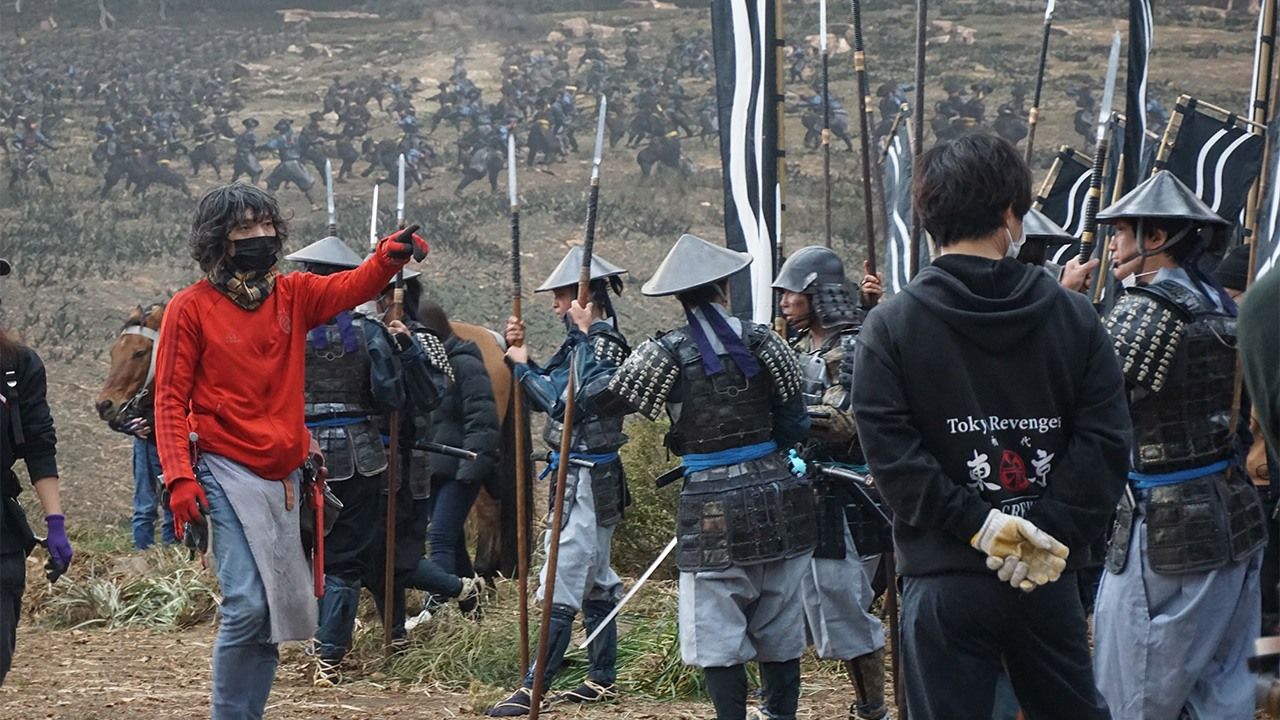
Technology Lends a Hand to TV Historical Drama
Culture Entertainment- English
- 日本語
- 简体字
- 繁體字
- Français
- Español
- العربية
- Русский
No Cast of Thousands
As a fan of samurai movies, I grew up watching such masterpieces as Kurosawa Akira’s Kagemusha (1980) and Ran (1985), in which the revered director shot lavish and frightening battle scenes by moving thousands of extras across vast plains. So I was puzzled when NHK invited me to watch the shooting of the 1600 Battle of Sekigahara inside a studio.
Granted, the Kadokawa Daiei Studio in Chōfu is fairly big, yet it was hard to imagine how they were going to pull off an indoor shoot of the largest and most important battle in Japanese feudal history—one that put a final close to the Sengoku (Warring States) period (1467–1568) and led to the establishment of the Tokugawa shogunate.
When I entered the building, most of the studio floor was covered in dirt and shrubs, and there were dozens of men on the battlefield—not a huge number, to be sure. Between takes, action coordinator Morokaji Yūta gave them instructions. The soldiers rehearsed their moves, punching, kicking, and slicing each other in slow motions before the assistant director, megaphone in hand, put everybody in position. Finally, he shouted “Action!” and everything happened in a few seconds—a blur of charges, shouts, and flying bodies.
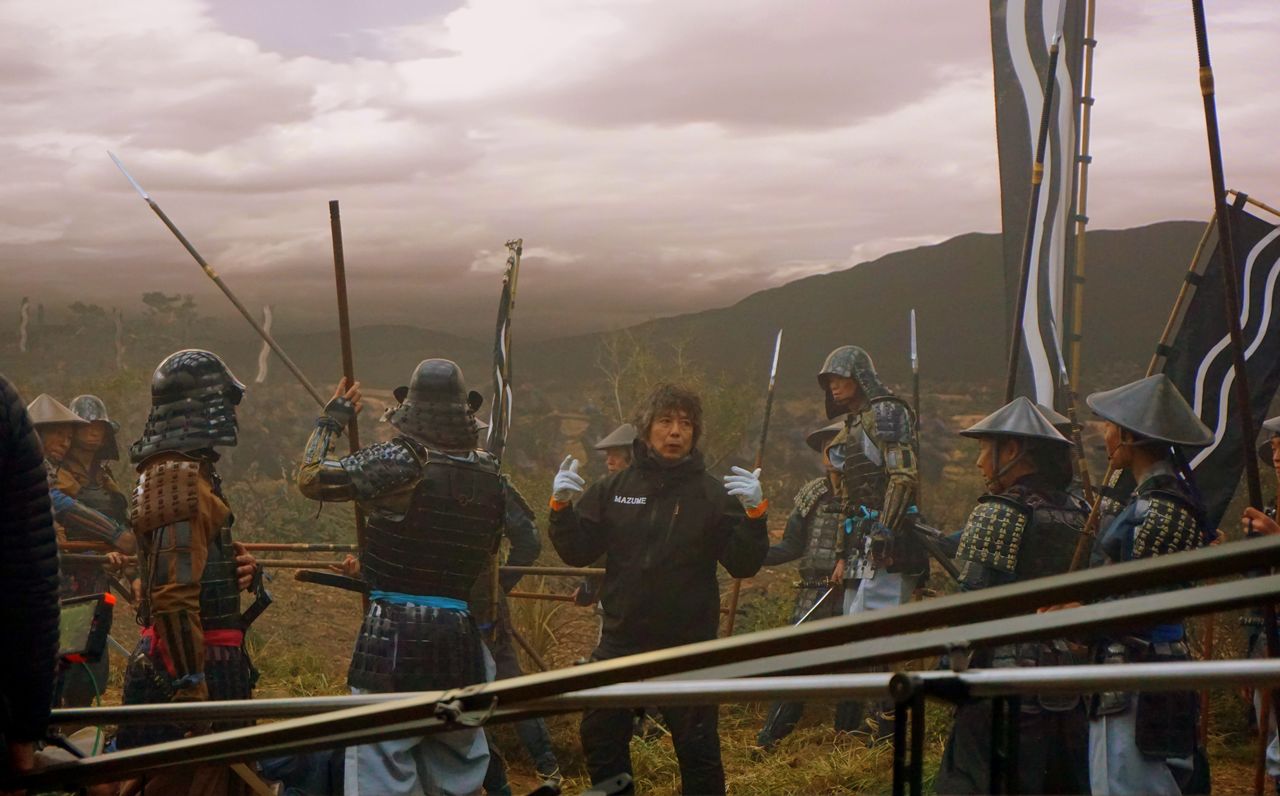
Morokaji Yūta, in gloves, gives instructions to the cast. (© Gianni Simone)
However, more than the action unfolding in front of my eyes, my attention was drawn to the back wall, where a huge LED panel showed thousands of soldiers swarming across a computer-generated landscape of the battlefield. The same background appeared on the camera screen and adapted to its movements.
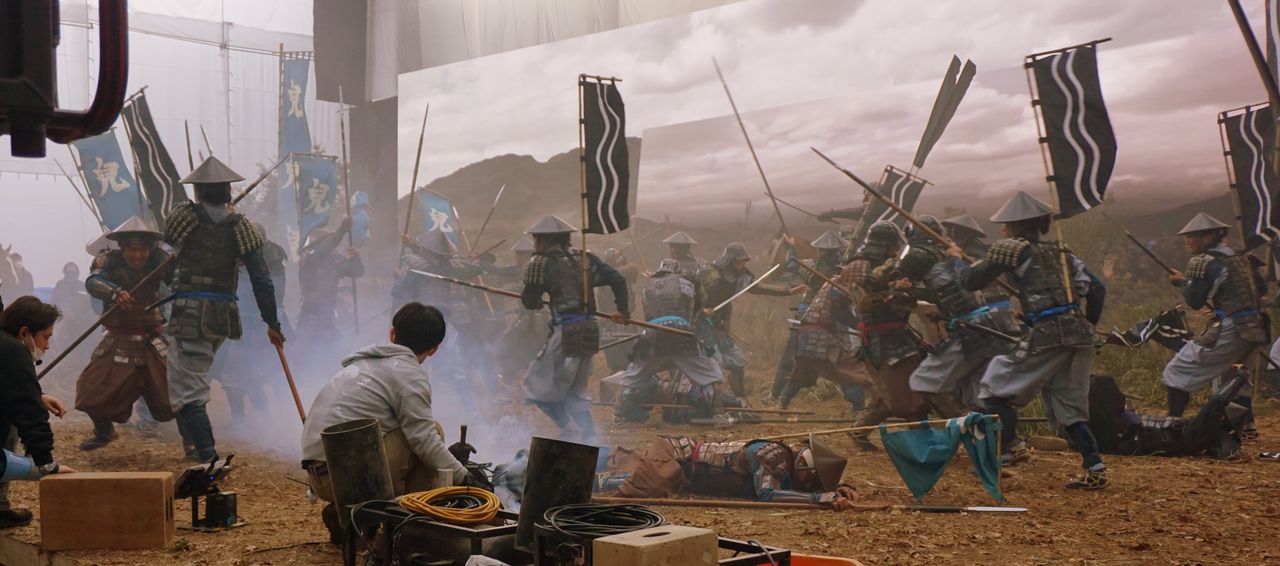
The Battle of Sekigahara. Almost like the real thing. (© Gianni Simone)
A Staple of the Japanese Television Scene
These scenes are part of this year’s taiga drama, What Will You Do, Ieyasu? A taiga drama is a historical series made every year by NHK, the country’s public broadcaster. It airs every Sunday at 8:00 pm, for a whole year, and is easily Japanese television’s grandest and most expensive production. To give an idea of the amount of work required to make this year’s series, some 150 people are involved in various ways, mainly taking care of the technical side of production. Shooting alone takes 15 months, while the entire project, from start to finish, takes more than two years.
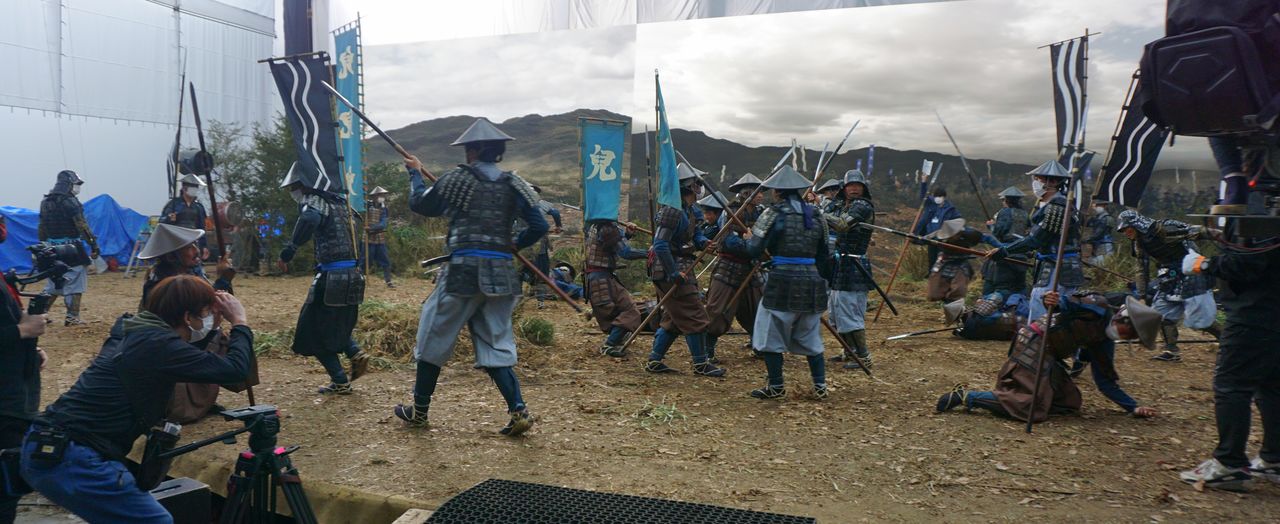
The great indoors. (© Gianni Simone)
This is the sixty-second taiga drama NHK has realized so far. Nearly all the stories portrayed in these series are based on actual history. In a few cases, some of the characters are fictional, but almost all dramas center on historical figures. What Will You Do, Ieyasu? for example, is about the life of Tokugawa Ieyasu, the feudal lord who at the beginning of the seventeenth century united Japan and ushered in more than two centuries of peace.
“About 60 percent of all taiga dramas are set in or around the Sengoku period,” explains this year’s director, Katō Taku. “After all, this is one of the most interesting and exciting periods in Japanese history. It features many battles, and arguably the three most famous historical figures: Oda Nobunaga, Toyotomi Hideyoshi, and Tokugawa Ieyasu. Every Japanese knows them, and they all lived at the same time and had a complex relationship, fighting and forming alliances with each other, depending on the circumstances. It makes for perfect TV drama material.”
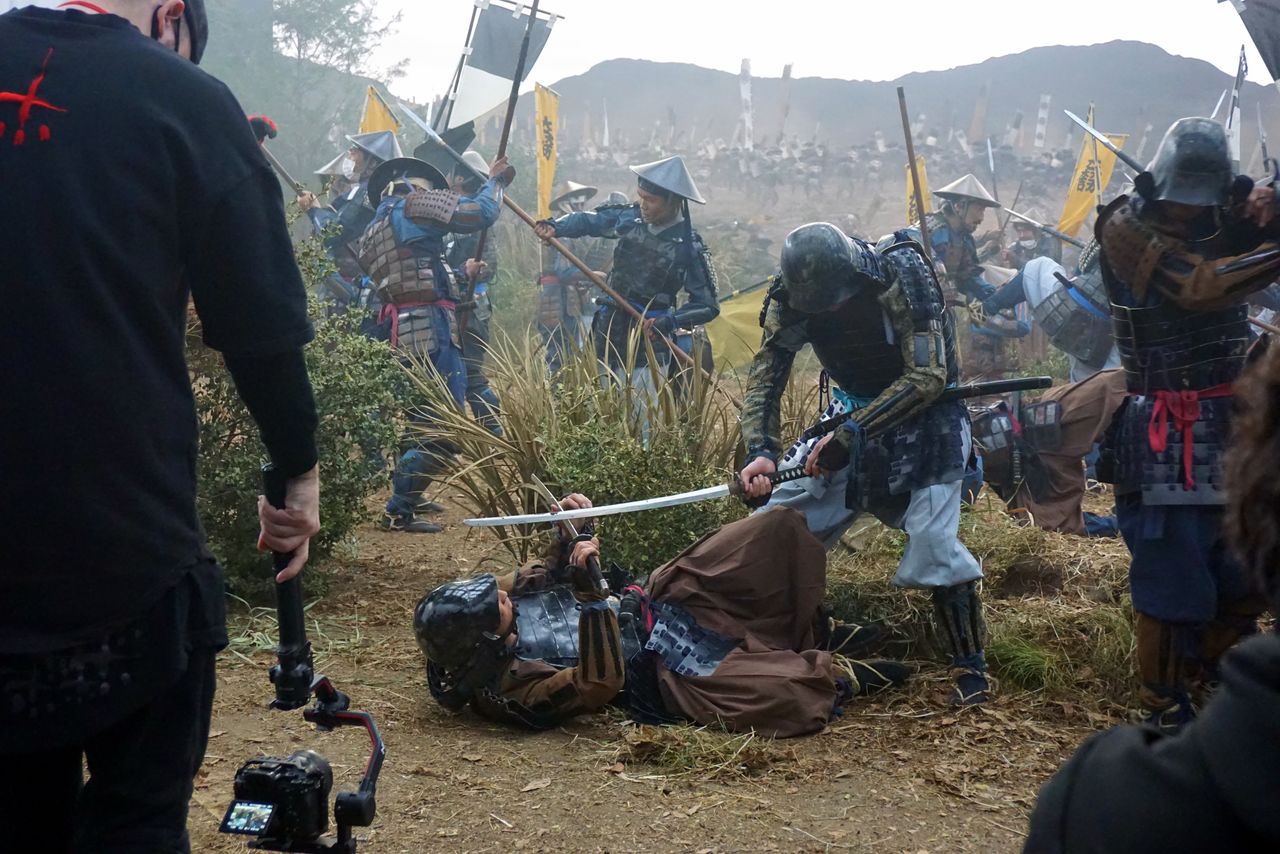
Even at close range, the fighting looks real. (© Gianni Simone)
Though taiga dramas have been long regarded as Japan’s most prestigious TV dramas, even inducing large-scale tourism to real-life locations, viewership ratings have declined considerably in recent years. The 30-plus-percent ratings of the good old days are a distant memory. Through the early 1990s these series still managed to achieve respectable figures in the 24%–26% range, but for most of the last decade they have stayed below 15%.
In order to revamp the genre, NHK has recently cast popular idols (including Arashi’s Matsumoto Jun and ex-SMAP member Kusanagi Tsuyoshi) and chosen stories that piqued contemporary viewers’ interest. “One thing that drew us to Ieyasu’s life is that he lived in a dangerous period in which the future was all but predictable,” Katō says. “This allows his story to resonate with people now.”
Katō goes on. “We live in economically troubled times and are just coming out of the COVID-19 pandemic. For the last three years, many people have felt anxious, angry, and isolated, and now more than ever we understand that if you don’t gather strength and fight through it with your friends, you will not be able to overcome those difficulties. In other words, we now realize that surviving these times is not so much about demonstrating strength and leadership as about protecting what’s important to us. It’s all about the kindness inherent in human beings, thinking of our friends and comrades. This is what makes Ieyasu a very contemporary figure. His actions were based on those feelings, and his victories were built on long-lasting relationships of trust.”
New Tech to Rekindle Old Excitement
There is no doubt, though, that this year’s trump card is the use of cutting-edge technology. According to Katō, mastering these techniques has been the biggest challenge this time around. “There are about 4,000 digital extras up there,” he says. “If done well, the background harmonizes with the scene shot in the foreground, and we can achieve the same splendid imageries portrayed on ancient picture scrolls from the seventeenth century. This has never been done before. In the past, if you wanted to have movements of troops and people of that size, you had to do it like Kurosawa and use an amazing number of extras.”
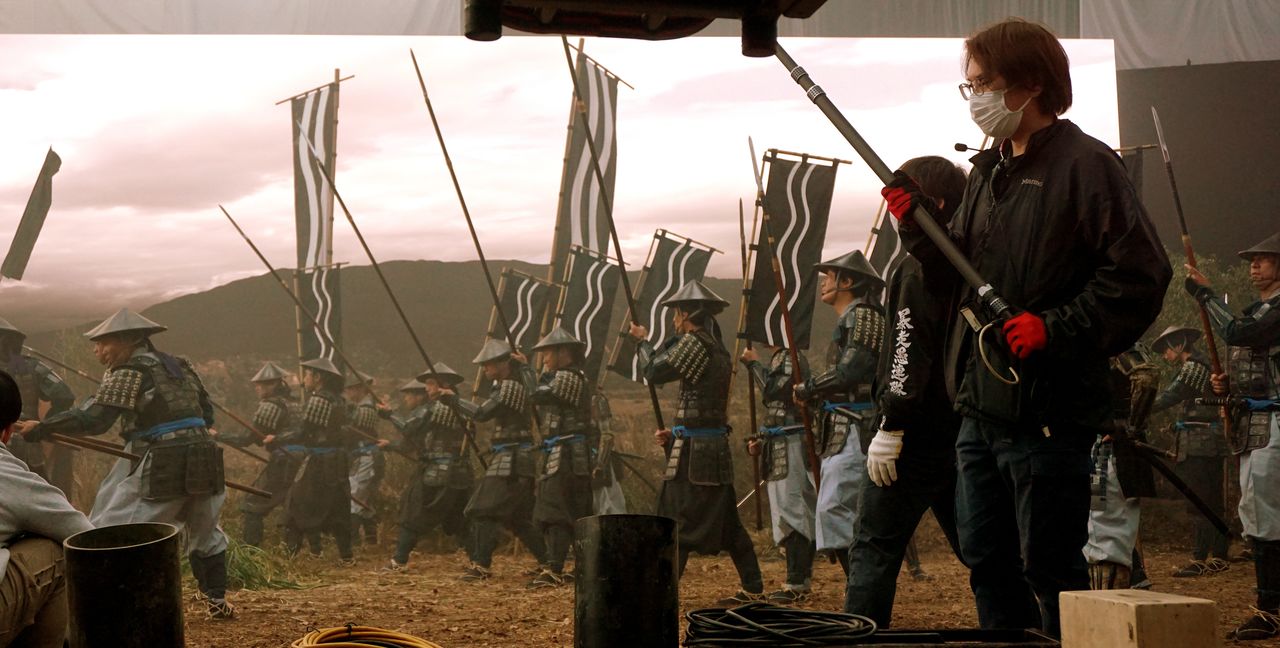
Extras with particular athletic skills were used for the battle scenes. (© Gianni Simone)
Re-creating those gorgeous picture scrolls and folding screens has been an unprecedented challenge, says Katō. “If you try to shoot that in reality, you have to take all the cast and crew to the location. Then there are all sorts of factors you can’t control, like unpredictable or extreme weather conditions. There are no convenience stores nearby, and everybody gets covered in mud. In this sense, the biggest purpose of virtual production is to use new technology to create a different way to produce a taiga drama, with the added advantage of being able to do it in the safety and comfort of the studio.”
Katō confesses that fine-tuning the technical side of this production was anything but easy. “The first time we tried it was last January, six months before the shoot was due to start, but the results were very disappointing. There was a point when I feared it wasn’t going to work. Luckily, everything clicked into place in the end, and it really shows in the mass scenes, with the flags flying, and thousands of people running around the vast plains.”
Battles aside, another great thing about the Sengoku period is the Japanese art and architecture of the magnificent Azuchi-Momoyama (1568–1603) culture, such as the period’s glittering folding screens. “In the second half of the story,” Katō says, “which features fewer battle scenes, we want to present the luxurious interiors of the samurai mansions on a grand scale, and this new technology will be essential to show the richness of the feudal castles in a way that has never been done before. I’m very excited about it.”
This is the fourth time Katō has been involved in a taiga drama production, and his second outing as a director. “This time, we want to highlight the entertainment factor. We want people to feel excited and have fun. Of course, war is always a tragedy, no matter what, but we are showcasing the gorgeous costumes of the samurai, just like the ones depicted in the old scrolls. There’s a lot of action, including by ninjas, and plenty of twists and turns. We are having fun shooting this drama, and hopefully, the audience will feel and share that. Of course, it’ll also be nice if the audience can learn something new about this historical period. In the end, I want to do something that people of all ages will enjoy watching on TV, just like in the past.”
(Originally written in English. Banner photo: The crew gets ready to shoot while a virtual battle rages on the screen. © Gianni Simone.)